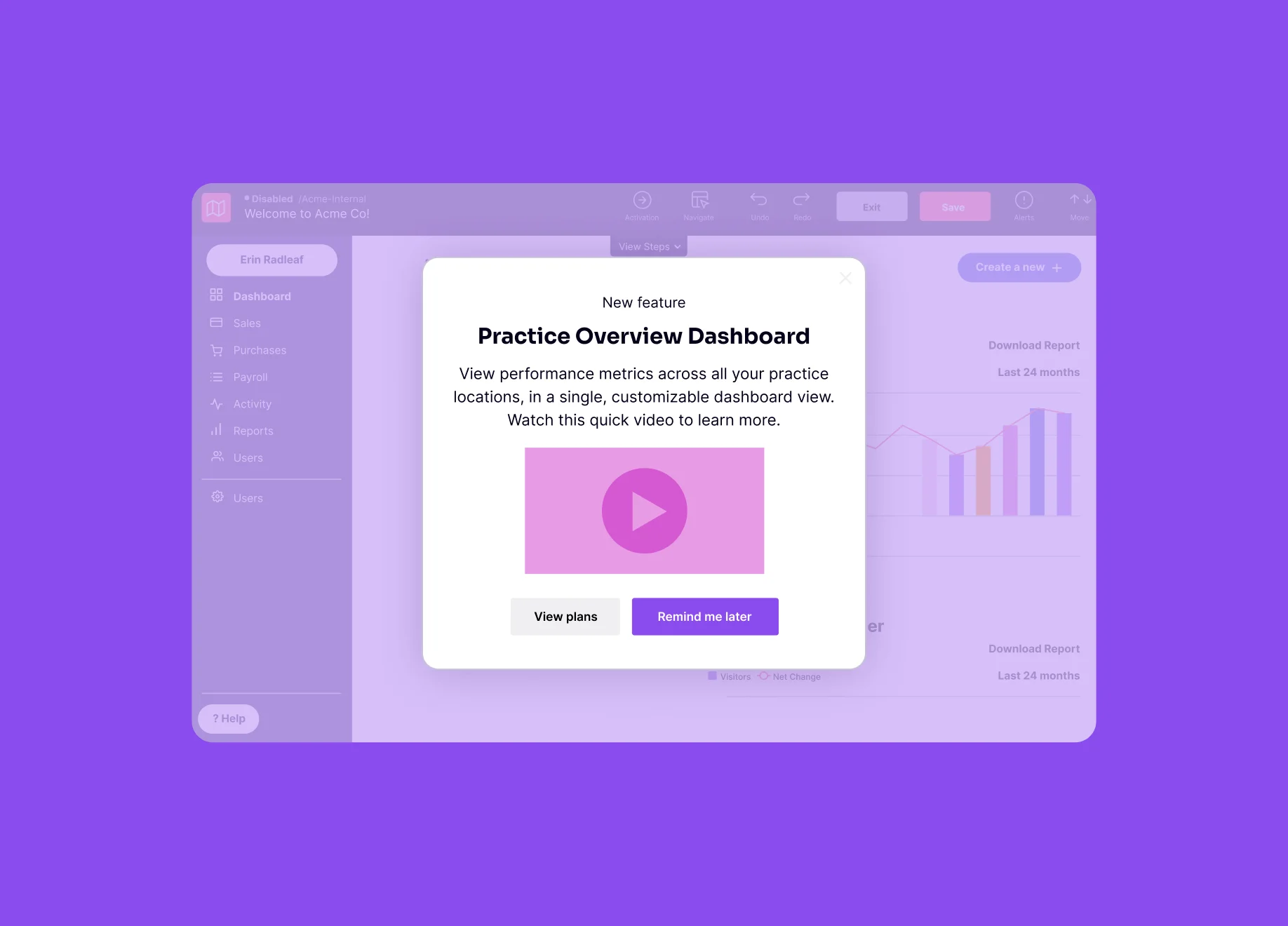
Adoption numérique
Capacité des utilisateurs à exploiter les outils numériques (logiciels, applications, sites Web, etc.) à leur plein potentiel.
Aller plus loin
Table des matières
What is digital adoption?
Digital adoption is the process by which users learn to leverage new technology (software products, apps, websites, etc.) to its fullest potential and derive maximum value from a digital process or solution.
L'adoption numérique est centrée sur l'humain et s'intéresse autant aux personnes qui utilisent la technologie qu'à la technologie elle-même. Son objectif est d'accroître la productivité, d'améliorer l'expérience des utilisateurs et d'optimiser les logiciels. Une bonne stratégie d'adoption numérique se situe à l'intersection de ces trois axes, et aboutit à la mise en place d'un lieu de travail numérique efficace et mature.
Pourquoi l'adoption numérique est-elle importante ?
In today’s rapidly evolving digital landscape, embracing new technologies and processes is no longer optional. It’s essential for business survival and growth. Consider the consequences to organizations without digital adoption.
- Les bouleversements numériques se poursuivent dans tous les secteurs, mais les entreprises risquent de se laisser distancer par leurs concurrents si ceux-ci adoptent des stratégies d'adoption du numérique qui leur permettent de gagner en efficacité, d'améliorer l'expérience de leurs clients et leur confèrent un avantage concurrentiel.
- Les entreprises dont la maturité numérique est insuffisante accusent un écart de productivité important par rapport à leurs homologues plus avancés, ce qui se traduit par des pertes de revenus et des occasions manquées.
- Sans les compétences ou l'assistance nécessaires pour utiliser efficacement les nouvelles technologies, les employés sont frustrés et baissent les bras, ce qui se traduit par un taux de turnover plus élevé.
- Et étant donné que les technologies numériques ne cessent d'évoluer, les entreprises qui peinent à les adopter ne profitent pas des possibilités d'innovation, de développement de produits et d'amélioration du service client.
According to a 2021 report from Harvard Business Review Analytic Services sponsored by Pendo, 89% of executives say that driving the adoption of employee-facing software is a priority, but only 30% say their organization is highly effective at doing it. The other 70% risk:
- Increased operational costs due to inefficient workflows and manual processes
- Loss of market share to competitors who actively leverage technology to boost sales
- Employee disengagement and attrition due to outdated tools and lack of training
- Reduced agility and innovation, without which they cannot adapt to a fast-changing landscape.
Pour atténuer ces risques et ouvrir la voie à une croissance et une réussite durables, les entreprises doivent s'assurer que les outils numériques dans lesquels elles investissent sont adoptés par leurs utilisateurs, aussi bien leurs employés que leurs clients.
Quelles sont les principales catégories ?
La plupart des initiatives d'adoption numérique entrent dans l'une des deux catégories suivantes :
Adoption numérique orientée client
L'adoption numérique orientée client se concentre sur l'engagement de l'utilisateur avec les produits ou applications orientés client. Elle a pour objectif d'améliorer la satisfaction des utilisateurs, de stimuler l'utilisation des produits et, au final, de fidéliser les clients. Par exemple, lors du lancement d'une nouvelle application mobile ou de nouvelles fonctionnalités logicielles, les stratégies orientées client garantissent que les utilisateurs peuvent naviguer facilement dans l'application ou comprendre comment découvrir et utiliser les dernières fonctionnalités, et donc les adopter.
Adoption numérique orientée personnel
Employee-facing digital adoption focuses on ensuring employees understand and effectively use internal software and tools to improve workflows, boost productivity, and achieve business goals faster and with less friction. For example, when deploying a new ERP system, an employee-facing strategy should make onboarding employees to the new platform as painless as possible.
Quels sont les avantages de l'adoption numérique ?
L'un des avantages les plus évidents de l'adoption numérique est l'augmentation du retour sur investissement de la technologie développée ou achetée par votre entreprise. Toutefois, les bons outils en la matière ne s'arrêtent pas là : ils produisent des résultats positifs dans l'ensemble de l'entreprise.
Digital adoption is also about empowering your workforce to leverage these tools effectively, transforming how your business operates and interacts with customers. When users (whether customers, employees, or both) maximize the value of their technology, they are happier, more productive, and more likely to remain users. Here are some of the most common benefits of:
- Improved workflows and internal efficiency — Imagine using a new project management tool to streamline team communication and collaboration, allowing for real-time updates, task delegation, and centralized file storage. This tool can eliminate lengthy email chains, scattered documents, misunderstandings, and errors, leading to faster completion of projects.
- Increased productivity — Adopting digital tools can automate repetitive tasks, freeing valuable employee time for more strategic work. For example, automated marketing campaigns or data entry tools can significantly reduce the time spent on mundane activities, allowing employees to focus on tasks that require creativity and critical thinking.
- Less user frustration with technology — Struggling users can quickly become overwhelmed and abandon new systems, hindering adoption and ROI. Digital adoption strategies like clear guides and in-app support minimize frustration and encourage continued engagement.
- Higher customer and employee satisfaction — Customers who can easily use a product or service are more likely to be satisfied and loyal. And empowered employees who can use a technology effectively experience greater job satisfaction and contribute more to the company.
- Reduced costs — Extensive training, errors, and rework can significantly increase operational costs. Digital adoption helps companies maximize their technology investments by minimizing training needs, streamlining processes, and reducing errors.
- Data-driven decision-making — Digital tools generate vast amounts of data on customer behavior, operational performance, and market trends. By leveraging analytics platforms, businesses can gain valuable insights to inform strategic decision-making and identify areas for improvement.
Quelle est la différence entre adoption et transformation numérique ?
Si les termes « adoption numérique » et « transformation numérique » sont souvent utilisés de manière interchangeable, il existe pourtant une différence essentielle entre les deux.
- Digital adoption refers to successfully integrating and utilizing new digital technologies within an organization. It ensures users (customers or employees) embrace and effectively use the latest tools and processes.
- Digital transformation is a much broader concept that encompasses the complete overhaul of an organization’s operations, culture, and business model to leverage the power of software and other digital technologies. It involves not just adopting new tools but also reimagining and optimizing how work gets done.
En bref, l'adoption numérique est un élément essentiel de la transformation numérique, qui consiste à utiliser des logiciels pour s'adapter à l'évolution des besoins. Par exemple, si une solution logicielle devait remplacer des processus manuels, on pourrait parler d'adoption numérique complète uniquement lorsque les employés auraient délaissé leurs anciens processus manuels au profit de la technologie numérique.
Quel rôle joue l'adoption numérique dans la transformation numérique ?
In a company where employees successfully adopt workplace software, digital transformation efforts are much likelier to succeed. Successful digital transformation, among other elements, means employees become confident and empowered to use the digital tools to help them thrive in the workplace. It’s also a process in which employees become a part of the change itself, providing business technology and ops managers with critical feedback and demonstrating new and better ways of working that can inform how they plan digital change for the better going forward.
Pouvez-vous nous donner des exemples ?
What successful digital adoption looks like can vary widely depending on the nature of a company and its goals. However, it always involves employees or customers or both embracing the digital tools they are provided, and it ends with elevated user experiences and stronger business outcomes.
For example, JLL, one of the foremost commercial real estate companies, successfully drove awareness and adoption of new features on internal-facing market research and data-visualization apps using in-app notifications and robust analytics. In doing so, they closely tracked user satisfaction with these apps and were able to improve ratings over time. Essity, a leading global health and hygiene company, was able to drive digital adoption by automating onboarding for its users and using in-app guidance to walk its sales employees through essential processes.
Ces exemples ainsi que les innombrables autres parcours réussis montrent que l'adoption numérique va au-delà de l'acquisition d'une nouvelle technologie. Avec les bons outils en main et la bonne formation, les utilisateurs participent activement à la transformation numérique de l'entreprise. Cela favorise l'innovation, garantit l'autonomie des employés, fidélise les clients et, au bout du compte, permet à l'entreprise d'être plus compétitive et plus performante.
Comment puis-je augmenter l'adoption numérique ?
Outre s'assurer que votre produit est aussi intuitif que possible, il existe des stratégies spécifiques qui permettent de stimuler l'adoption numérique par l'ensemble des utilisateurs d'une entreprise :
- Onboarding: By creating an effective onboarding strategy, companies can ensure users — employees or customers — become proficient in an application as quickly as possible and recognize its value, driving retention and preventing churn. For example, you can provide:Tailored experiences: Create different onboarding experiences for new users based on their roles and needs.
- Interactive tutorials: Go beyond static text instructions and provide interactive tutorials, walkthroughs, or short videos to guide users through key features.
- Clear value proposition: Communicate the value proposition of the software app and how it benefits users in their daily tasks.
- Measurable outcomes: Track key metrics during onboarding, such as time to complete tasks, to identify areas for improvement.
- In-app guidance: Beyond onboarding, users need contextual information while using the product. Many companies use in-app messaging to communicate at the right moments and guide users to success. Cartegraph uses in-app messages to drive behaviors in their app that lead crews to complete fieldwork more efficiently. Six months after launching these guides in their mobile app, the team saw a 62% increase in mobile adoption. Other helpful features might include:Contextual walkthroughs: Trigger short, interactive walkthroughs based on user actions or specific features the user is accessing.
- Tooltips and cheat sheets: Offer quick, contextual tooltips and cheat sheets that provide easy-to-access reminders and guidance within the application.
- Search functionality: Implement a robust search function within the app to allow users to find answers to their questions quickly and efficiently.
- Ongoing education: Since digital adoption is a continuous process, it’s vital to keep users engaged and informed with ongoing educational resources after onboarding is complete, especially when there are any product releases, changes, or updates. Some tactics include:Regular webinars and training sessions: Host regular webinars or training sessions to highlight new features, address common questions, and showcase best practices.
- Knowledge base and user guides: Develop a comprehensive knowledge base and user guides that provide easy-to-find documentation and resources for ongoing reference.
- Change management communication: Communicate product updates, changes, or new features through multiple channels to ensure users are aware of ongoing improvements.
De nombreuses entreprises se tournent vers les plateformes d'adoption numérique pour mettre en œuvre ces pratiques de manière efficace. Ces plateformes peuvent aider à automatiser les tâches, à personnaliser l'expérience utilisateur et à suivre les progrès vers les objectifs d'adoption numérique.
Comment puis-je mesurer l'impact de l'adoption numérique ?
Digital adoption of internal software is typically measured by increased employee productivity, whereas customer-facing digital products are measured against various business KPIs and, for sophisticated organizations, product experience targets.
Indicateurs clés de mesure
Pour mesurer le succès de l'adoption numérique, il faut suivre des paramètres essentiels pour les utilisateurs internes (en contact avec les employés) et externes (en contact avec les clients). En voici quelques-uns, ainsi que la manière de les suivre. (Remarque : Une plateforme d'adoption numérique efficace peut suivre et enregistrer ces données automatiquement).
Indicateurs orientés personnel
- Login frequency and active usersHow to track it: Measure the number of users logging in and actively using the software over time.
- Why it’s important: It can indicate user familiarity and engagement with the new tool.
- Task completion ratesHow to track it: Monitor the percentage of users completing specific tasks within the software.
- Why it’s important: It helps identify areas where users might need additional training or support.
- Time spent on tasksHow to track it: Analyze the average time users spend completing specific tasks within the software.
- Why it’s important: A decrease in time spent can indicate improved efficiency and proficiency.
- Help desk tickets and user feedbackHow to track it: Measure the number of help desk tickets related to the new software.
- Why it’s important: User feedback can help identify areas of confusion or difficulty.
Indicateurs numériques orientés client
- Active users and feature adoptionHow to track it: Track the number of users actively engaging with the application and the specific features they utilize.
- Why it’s important: It provides insight into user behavior and feature popularity.
- Conversion ratesHow to track it: Monitor the percentage of users completing desired actions within the application, such as making a purchase, subscribing to a service, or completing a registration form.
- Why it’s important: An increase in the completion of desired actions can indicate whether a recent change in user interface or marketing is effective.
- Time spent on featuresHow to track it: Analyze the average time users spend on specific features within the application.
- Why it’s important: It can indicate user engagement and areas where they might find value.
- App ratings and reviewsHow to track it: Monitor user ratings and reviews on app stores or other platforms.
- Why it’s important: It helps gauge overall user satisfaction and identify pain points.
En suivant ces indicateurs et en analysant les données, vous pouvez obtenir des informations précieuses sur le comportement des utilisateurs et identifier les domaines à améliorer dans vos stratégies d'adoption numérique. Ce processus continu permet de garantir que vos utilisateurs tirent le meilleur parti de la technologie, qu'ils en maximisent la valeur et qu'ils obtiennent les résultats métier souhaités.
Où peut-on en apprendre plus sur l'adoption numérique ?
For those looking to dig deeper into digital adoption and DAPs, Pendo has published information on how to operationalize driving digital adoption and measure results.
Découvrez comment Pendo vous aide à favoriser l'adoption numérique
Vous aimerez peut-être aussi

Pourquoi la meilleure stratégie d'adoption numérique prend des données comme point de départ
How to form the right digital adoption strategy



